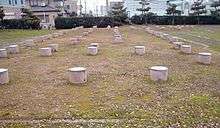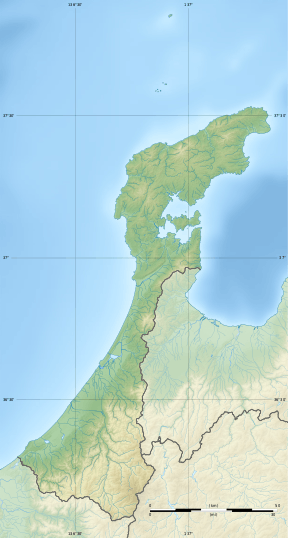Tōdai-ji Yokoe Shōen
Yokoe Shōen Site (東大寺領横江荘遺跡, Tōdai-ji-ryo Yokoe-no-shō iseki) is a Heian period to Sengoku period archaeological site consisting of the ruins of a shōen located in what is now part of the town of Hakusan, Ishikawa Prefecture in the Hokuriku region Japan. It has been protected by the central government as a National Historic Site since 1972.[1]
東大寺領横江荘遺跡 | |
 Yokoe shōen Site | |
 Yokoe shōen Site  Tōdai-ji Yokoe Shōen (Japan) | |
| Location | Hakusan, Ishikawa, Japan |
|---|---|
| Region | Hokuriku region |
| Coordinates | |
| Type | settlement |
| History | |
| Founded | 9th century |
| Periods | Heian period |
| Site notes | |
| Condition | ruins |
| Ownership | National Historic Site |
| Public access | Yes |
Overview
The site contains the ruins of a large manorial estate established in 818 AD by Emperor Kanmu to Crown Princess Asahara and was inherited by her daughter Princess Sakahito. It was then donated to the great temple of Tōdai-ji in Nara. After several centuries, the estate came under control of the Zen temple of Tenryū-ji in Kyoto.
The ruins of the Heian period manor house was discovered in 1970 during construction of an industrial park. The foundation pillars for a large house, presumably the administrative building of the manor and a number of warehouses were discovered, along with wooden tags and shards of pottery. The main building was surrounded by a cloister-like covered corridor, in the manner of contemporary temples.
The site is now a public archaeological park, with concrete pillars marking the locations of foundation posts.
From 1984 to 1991, a site called the Kamiaraiya Site (上荒屋遺跡l) on a riverside in what is now part of the city of Kanazawa was excavated. It was found to have been the port facilities for the Yokoe Manor, and the site was added to the National Historic Site designation.
References
- "東大寺領横江荘遺跡". Cultural Heritage Online (in Japanese). Agency for Cultural Affairs. Retrieved 25 December 2017.(in Japanese)
External links
- http://www.city.hakusan.ishikawa.jp/kyouiku/bunkazaihogo/info/toudaijiryouyokoenoshouisekiuwoku.html Hakusan city information] (in Japanese)
- Ishikawa Prefecture official site (in Japanese)